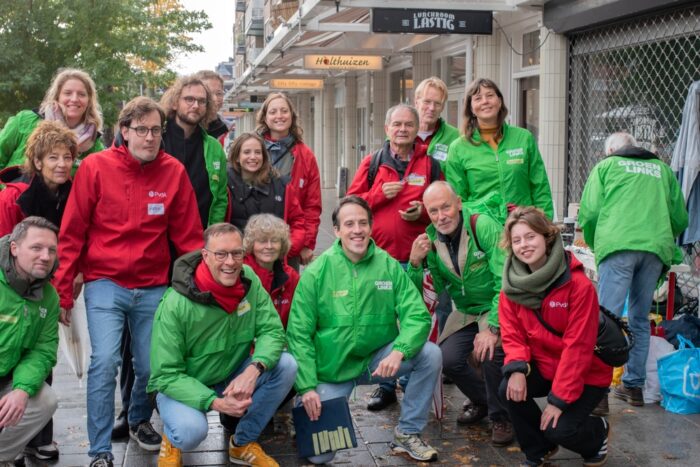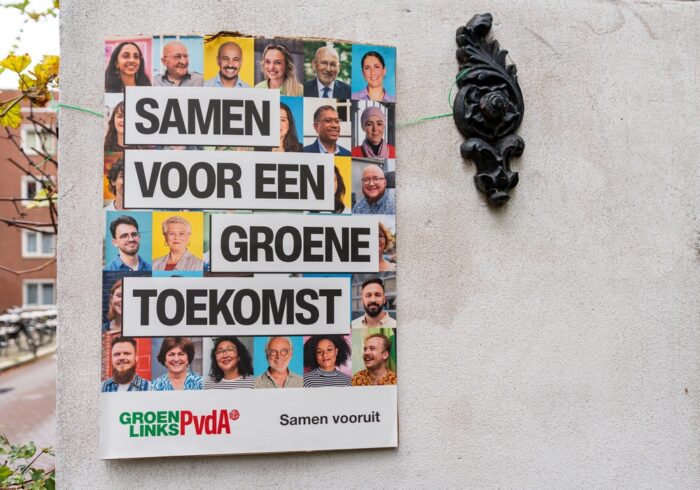The Progressive Post
A landslide victory of a fragmented Dutch right wing



The surprise win of the anti-immigration Party for Freedom of Geert Wilders in last week’s Dutch election indicated the realignment of the party system. The deep rifts within and fragmentation of the populist and centre-right makes forming stable coalitions highly problematic. This watershed moment in Dutch politics caused a wave of shock and anxiety among Western Europe’s political establishment.
In a landslide victory, Geert Wilders’ Party for Freedom (PVV) became the largest party in the Dutch parliamentary elections on 22 November, after Dutch voters cast their ballots in a snap election, called after the collapse in July of the outgoing four-party coalition government headed by Mark Rutte, the longest ever serving Dutch Prime minister. However, it is far from certain that Wilders will actually become Prime Minister as the other right-wing parties seem very reluctant to join his political project.
For many observers, the idea of Wilders becoming Prime Minister is mind-boggling as up until the week before Election Day, Wilders’ anti-Islam party was trailing mainstream centre-right and centre-left opponents. During most of the 2023 election campaign, three parties were vying for the lead in the polls: the People’s Party for Freedom and Democracy (VVD), where Rutte had been replaced by the first female leader of the party, Dilan Yesilgöz-Zegerius, a GreenLeft-Labour alliance (GL/PvdA), led by former EU-Commissioner Frans Timmermans and New Social Contract (NSC), a brand-new party led by a popular former Christian Democrat MP Pieter Omtzigt.
The late surge in support for the PVV was due to the decision of the VVD to abandon the usual strategy employed against populist opponents: isolate and imitate. As mainstream right-wing parties have done across Europe, the VVD habitually made clear to voters that the populists would not be a viable coalition partner, while at the same time, they would adopt watered-down versions of the anti-immigrant stances of their populist challenger.
However, only a few days before the 2023 elections, VVD leader Yesilgöz told voters that she did not rule out forming a coalition with Wilders, giving permission for right-wing voters to support the more radical – and authentic – anti-immigration version. As if he anticipated this move, Wilders himself had already toned down his usual hateful rhetoric and tried to convince centre-right voters that he would not violate the Dutch constitution and be a prime minister for ‘all Dutch people’. Although Wilders did not specify who he considers Dutch, this convinced many hesitant voters to switch and bolster PVV support from around 18 to 37 seats, an unprecedented gain in only a few days.
At every Dutch election since 2003, voters have expressed their discontent with mainstream parties by turning to radical actors. In 2006 it was the radical left Socialistische Partij (SP) with 16.6 per cent of the vote that was the electoral vehicle of discontent, and between 2010 and 2021 the mantle of discontent fell to Geert Wilders Partij voor Vrijheid (PVV). But never until last week has a party from the radical fringe topped the poll, nor obtained more than 20 per cent of the vote. When the 23.7 per cent achieved by the PVV is added to the vote for the centrist anti-establishment new entrant Nieuw Social Contract (NSC), and the Citizen-Farmers Party (BBB), a striking 42,3 per cent of Dutch voters lent their support to parties explicitly critical of the country’s political establishment.
That even larger vote transfers were possible, with Dutch voters ordinarily considering three of four parties, had been shown earlier in 2023, when Provincial elections were held through which also the Senate is elected. In that election, voters had already strongly voiced their discontent with the incumbent government by supporting the recently founded party Farmer-Citizen Movement (BoerBurgerBeweging, BBB in Dutch). This new party became the largest party in all Provinces. As the Senate is indirectly elected through the provincial councils, BBB is now the largest party in the Senate, which is relevant as all legislation needs to pass both the House of Representatives (Tweede Kamer) and the Senate.
BBB had emerged as a reaction to Rutte’s fourth government’s inability to decide how to deal with a court decision that nitrogen emissions in agriculture had to be reduced. The government policy to buy out farmers met with strong resistance from farmer communities who staged – often violent – protests and road blockades. Wealthy agro-business companies funded the new BBB, and it gained one seat in 2021. BBB leader Caroline van der Plas proved a very effective voice of popular discontent framing the ‘attack on farmers’ in a nostalgic populist rhetoric of the disappearance of traditional Dutch culture, way of life and landscape. While still dominating the polls in March, by November 2023 BBB had lost most of its appeal after it nominated the ex-CDA MP Mona Keizer as prime minister candidate, who faltered in interviews when probed about her economic knowledge and policies. As a consequwnce, many BBB-supporters now switched to the Omtzigt’s new anti-establishment party NSC.
The emergence of the two newcomers – BBB and NSC – created a totally different campaign dynamic, which, combined with the strategic miscalculations led to the electoral implosion of the centre right VVD and CDA (Christian Democratic Appeal) coalition partners. The Netherlands’ four-party coalition of the liberal VVD, the progressive D66 (Democraten ’66), the orthodox Christian Union (CU) and centre-right CDA fell apart in July 2023 over its plans to reduce migration levels by restricting family reunification of asylum seekers. Having fallen out over migration, the centre right VVD made the mistake of fighting the election on the issue and the ground which is most favourable to Wilders and the PVV. Having already lost the ‘prime-ministerial electoral bonus’, and to compound the error of making immigration more salient than the question of the cost of lining which was on many voters’ minds, the new liberal leader Yesilgöz indicated that the VVD would be open to forming a coalition with Wilders, but only if the VVD was the largest party. This not only removed one of the principal factors constraining voters sympathetic to Wilders from voting for his populist party, the arrogance of power also irritated many voters. As a consequence, support for the outgoing collation completely melted down, falling from 49,2 per cent in 2021 to just 27.9 per cent in 2023.
With 37 seats in a 150-seat legislature, PVV got twice as many seats as predicted in opinion polls before the elections, and managed to more than double its number of seats compared to 2021. The GreenLeft/PvdA alliance came second with 25 seats, which is 8 seats more than the two parties got separately in the 2021 election, indicating only a partial recovery from the two parties’ worst-ever combined vote two years ago. Since the left-wing parties combined lost 19 seats, this is a disastrous result and a failure of the electoral alliance of two mainstream left parties to mobilise a progressive opposition to the radical right.
In July this year, the members of the Netherlands’ two mainstream parties of the left, the Dutch Labour Party (PvdA) and the Green-Left (Groen Links), voted overwhelmingly to run on a joint programme and with a joint candidate list at the election. Choosing the veteran Social Democrat and European Commissioner Frans Timmermans as its leader, the alliance hoped to rally the Dutch left around a vision of a ‘social and green’ Netherlands. The alliance failed to mobilise left and centrist voters and form a strong block in parliament that could prevent the formation of an ultra-right government. Overall, the Dutch left – consisting of GL/PvdA, the radical left Socialist party (SP), the Animal Rights Party (PvdD) and the radical left BIJ1 (Coming Together) – fell to its worst electoral result in more than 40 years and ended up winning the support of barely 21,6 per cent of Dutch voters.
An unprecedented level of electoral volatility of Dutch voters resulted in a fundamental realignment of the centre and right parties in the Dutch political system. The right flank in Dutch politics is now made up of the centrist social-liberal parties D66 and Volt, the mainstream right parties CDA and VVD, the anti-establishment NSC and BBB, the populist parties PVV and JA21 (Right Answer 21) and the extreme right FvD (Forum for Democracy).
The figure below illustrates how dramatic this realignment on the right has been. The dominance of the Dutch right by VVD and D66 in 2012 has disappeared in 2023 to be substituted for by the PVV and NSC, who, together, now account for virtually 50 per cent of the vote for right-wing parties in the Netherlands.
With the populist, anti-establishment block now being almost as large as the traditional centre-right parties – if we add NSC to the moderate right because of its deep roots in CDA circles, while we keep BBB in the populist bracket– Dutch politics has transformed into a system where three political blocks compete. This three-way division between the populist, authoritarian and nativist right block, the Left-plus-Green block and the liberal centre/centre-right block is similar to the French situation in 2022. This shift in the balance between party blocks may be a precursor of what could become a dominant pattern in the European elections of 2024.
Photo credit: Shutterstock.com/PixelBiss




